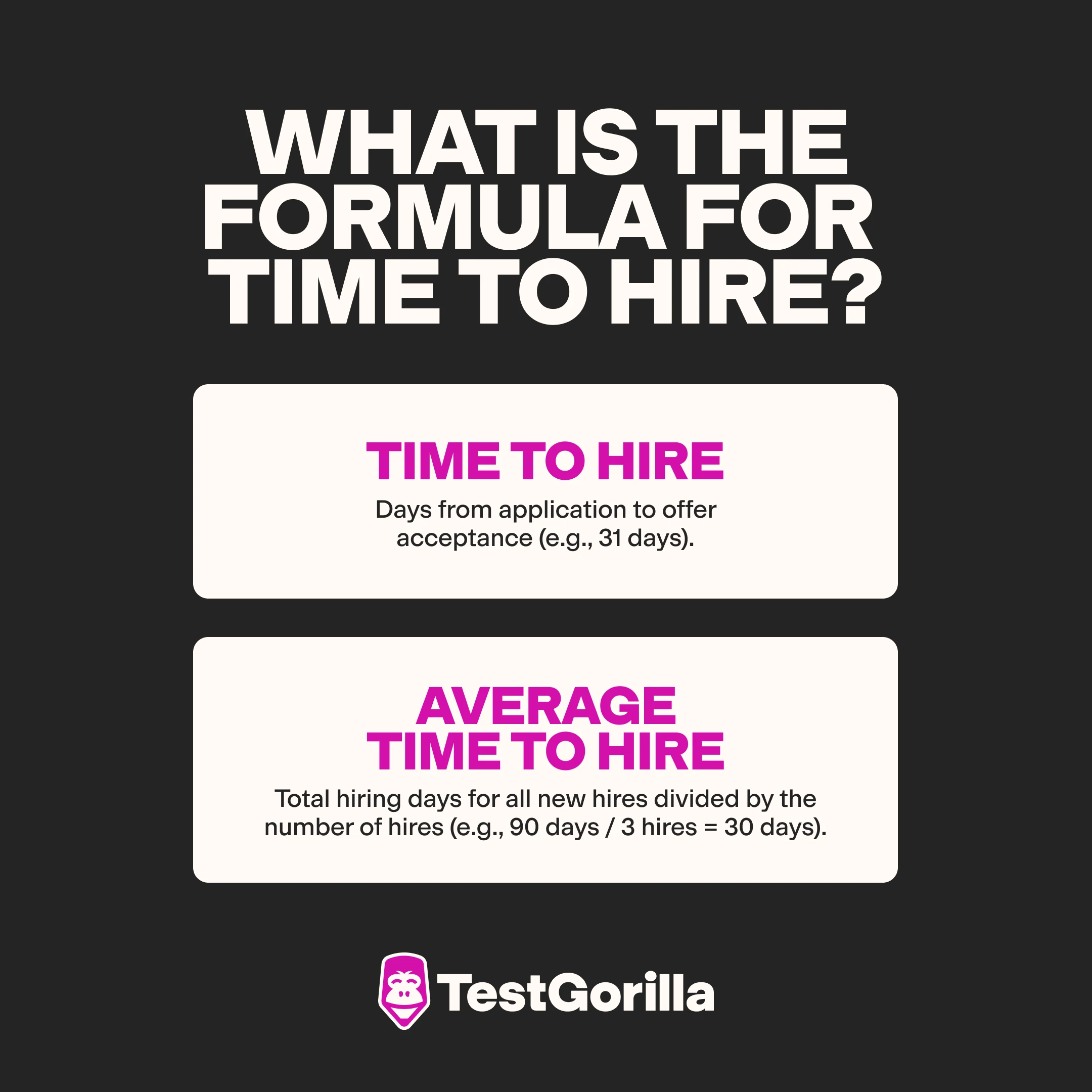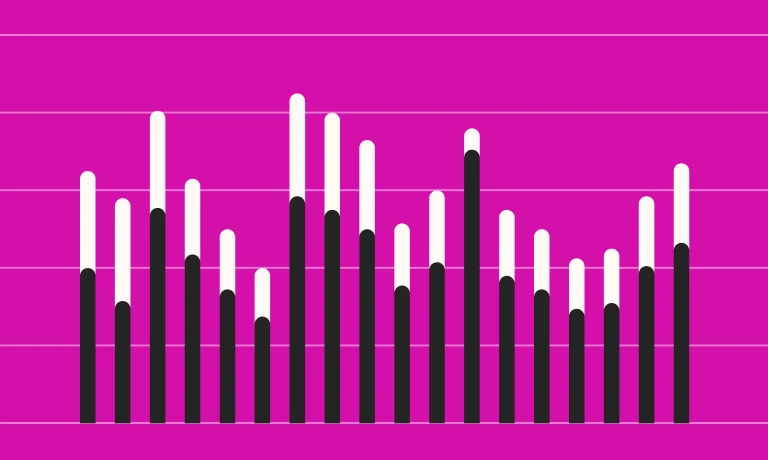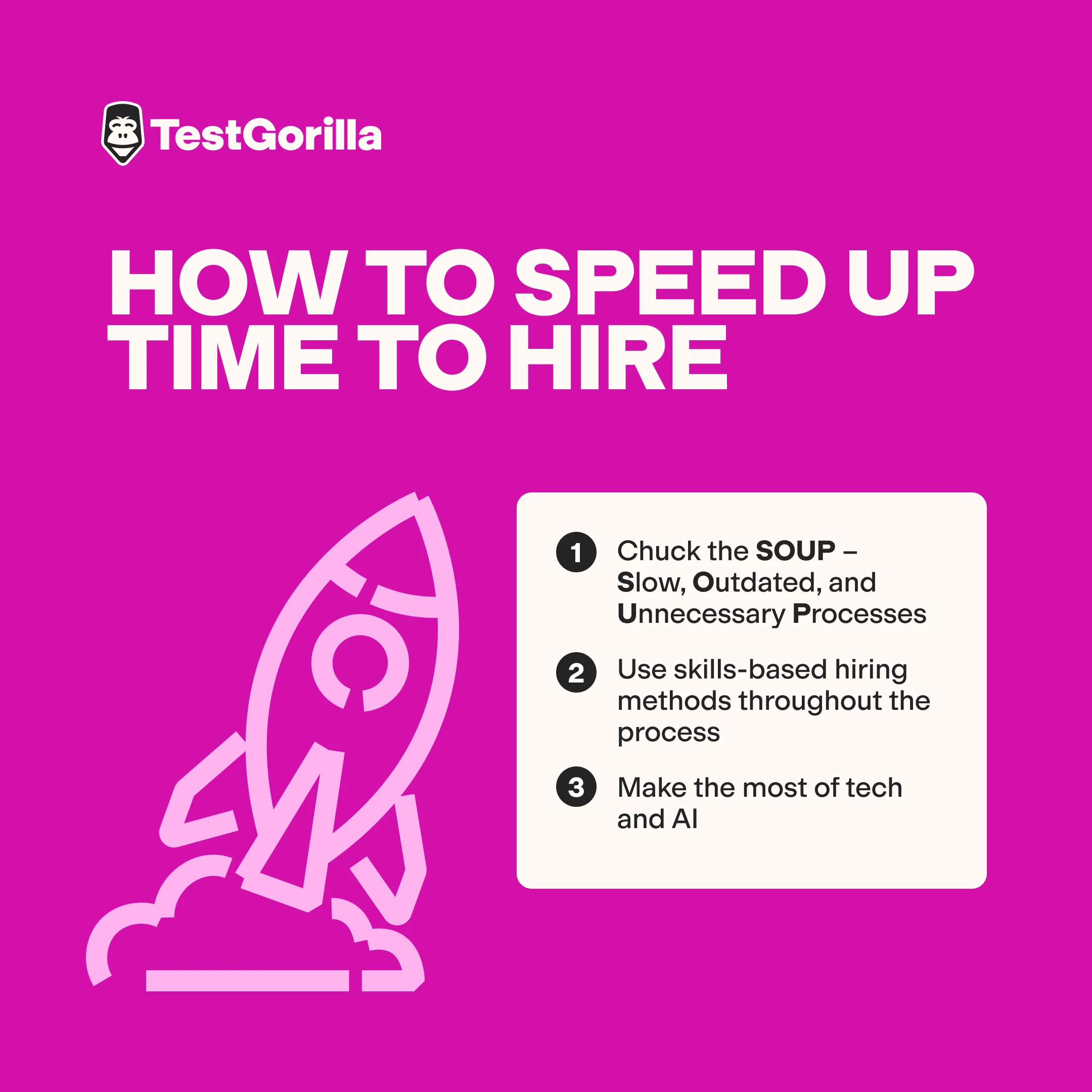Think that a longer recruitment process will guarantee amazing hires? Think again.
Yes – a thorough hiring process will help you select top talent and avoid making rushed decisions. But thorough doesn’t mean long and drawn out. In fact, long hiring times can lead to missed opportunities, higher costs, and frustrated candidates who’ll move on to more efficient employers.
That's why you must monitor your average time to hire and strike the right balance between hiring fast and hiring right.
In this guide, we tell you how to calculate your current time to hire and then shorten it – so you can land top-notch candidates.
What is time to hire?
“Time to hire” is a recruitment metric that measures the number of days from when an individual first enters the candidate pool for a job – regardless of whether they’re sourced or actively apply – to the day they accept an offer for the position.
Why is knowing your time to hire important?
Knowing this metric can help you determine if you need to reduce your time to hire.
A shorter time to hire might indicate that your recruitment process is running smoothly and quickly – meaning you’re probably snagging good candidates before competitors get to them.
Conversely, a longer time to hire could signal inefficiencies or bottlenecks in your hiring process that you should address to avoid losing top talent to competitors.
Tracking time to hire can help you identify these inefficiencies and determine solutions.
Why is a shorter time to hire beneficial?
There are various benefits to a shorter time to hire. Here are three.
Creates a positive candidate experience
Applicants often have a more positive candidate experience with faster hiring processes.
Forbes explains that fast, streamlined, and personalized hiring processes encourage candidates to accept offers and share their shining reviews with others.
On the other hand, People Management showed that 78% of 3,700 job seekers either dropped out – or considered dropping out – of long or complex recruitment processes.
Keeps costs in control
We’ve already seen that slow hiring can lead to a poor reputation in the job market. But one study also showed employers with a bad reputation could pay up to 10% more wages to attract candidates for their roles.
Additionally, you’re also losing money for every day a role is vacant. An employee's value to a company can be up to three times their pay. So, if a position’s salary is $600/day, the company can lose up to $1,800/day in missed opportunities, low productivity, poor customer experience, and more until the position is filled.
A reduced time to hire avoids these costs.
Want to get more value from your recruitment?
Our complete blueprint will provide the tips, strategies, and insights you need to maximize your recruitment ROI.
Helps you land top talent
The best talent is available in the market for an average of 10 days only. A quick time to hire ensures you don’t miss out on high-quality candidates who might be otherwise snapped up by more proactive recruiters.
What is the formula for time to hire?
To calculate your time to hire, count the number of days between the date a candidate entered the hiring process and the date they accepted the offer. So if your candidate applied for a job on January 1st and accepted the offer on February 1st, your time to hire was 31 days.
To get your average time to hire, add the total number of days it took to hire every candidate within a period. Divide this total by the number of new hires made. For example, if it took you a total of 90 days to hire three new candidates this year, your average time to hire is 90/3, which is 30 days.
Some companies simply track candidate application and job acceptance dates. However, HR expert Yashna Wahal emphasizes, "If you truly want to identify which part of the hiring process is taking longer than it should, then track dates throughout the hiring process.”
Here’s an extended calculation in action.
Application submission: The candidate submits their application on January 1st.
Initial screening: The hiring team reviews the application and conducts an initial screening before reaching out to the candidate on January 8th. (7 days)
Interviews: The candidate undergoes multiple rounds of interviews with different stakeholders. The last interview is January 22nd. (14 days)
Offer stage: The hiring team makes decisions and extends an offer to the candidate on January 28th. (6 days)
Negotiation: The candidate negotiates the terms of the offer. (4 days)
Offer acceptance: The candidate accepts the offer on February 1st.
In this example, the time to hire is 31 days. But now we can see that the screening, interview, and offer stages might be taking longer than they should.
Time to hire vs. time to fill
“Time to hire” and “time to fill” are often used interchangeably, but they’re actually calculated differently. While time to hire is the number of days it takes between sourcing and hiring a candidate, time to fill measures how long it takes to fill an open position from the date you decided to hire for the role to the date the candidate accepts the offer.
The best insights on HR and recruitment, delivered to your inbox.
Biweekly updates. No spam. Unsubscribe any time.
What is the average time to hire?
Bersin & Associates, a research company, looked at half a million global data points across eight industries and 25 countries. Findings showed that, on average, it takes companies 44 days to fill open positions. This is up from 43 days in 2022.
The study also stressed that time to hire is at an all-time high, has become longer across all industries, and will continue to be challenging for most jobs.
Why is it difficult to cut time to hire?
Shortening the hiring process can feel challenging for so many reasons.
Higher application volumes and leaner recruiting teams mean it can take tons of time to screen candidates. Companies hiring without dedicated recruiters could take even longer as employees juggle both hiring duties and their day jobs.
Further, some employers also feel that reducing the time to hire will lead to rushed hiring decisions, while others struggle to get team members on the same page to make quick decisions.
In addition to some of these general factors, the trends below make it even harder to cut time to hire in today’s landscape.
Identifying top candidates is hard
63% of employers say it's getting harder to find top talent in 2025 – and more than half of them say determining if candidates have the right skills (both soft and technical) is the most difficult part of their hiring process today.
On top of this, 86% of US and 89% of UK employers cite having problems with resumes. With the majority of employers still doing a resume screen as a first step in their hiring process, many are missing out on top candidates who don’t have the typecast resume they’re looking for.
45% say filtering by resume is the most difficult part of their hiring process today. Source: The State of Skills-Based Hiring 2025
The rise of remote working
You’d think a process run entirely online is quick and efficient. But, HR expert Yashna Wahal challenged this notion while sharing some of her first-hand hiring experiences.
Hiring for remote jobs has opened the doors to talent across the globe. While this is amazing, don’t underestimate how long it can take to coordinate interviews and hiring team meetings across different time zones.
And that’s not all. Even local remote roles can take longer to hire for because without face-to-face interaction, you’re often less confident in candidates’ skills and abilities. As a result, you take extra precautions.
More selective candidates
According to a report by the Society for Human Resources Management (SHRM), the war for talent has tipped the scales in favor of employees and candidates who want better pay, benefits, and flexible work arrangements.
Today’s candidates are more selective about where they want to work. They often research a company’s culture, values, benefits, and development opportunities before committing to a job. This can lead to a longer hiring process as candidates take longer to decide or negotiate offers.
Increased focus on diversity
A growing number of companies are looking to ramp up diversity in their hiring processes. Some are realizing that businesses with diverse workforces perform better than the competition and attract job seekers who prefer working for diverse companies.
That’s why many hiring teams today go the extra mile when assessing candidates, ensuring that decisions are free from unconscious bias, candidates have been evaluated fairly, and so on. Some companies even have HR checks in place to monitor these processes. While this is excellent in so many ways, it can lead to a longer hiring cycle.
How can I speed up time to hire?
Here’s how you can shorten your time to hire without compromising on the quality of your recruits:
Chuck the SOUP – Slow, outdated, and unnecessary processes
Use skills-based hiring methods throughout the process
Make the most of tech and AI
1. Chuck the SOUP – Slow, outdated, and unnecessary processes
First, you need to evaluate what parts of your application process aren’t worth the time they take. Here are some.
Long application forms
Some application forms require excessive detail. For instance, say you ask candidates to detail their entire employment history – which can go back years. Many of these details likely aren’t relevant to the job, plus the applications will take you a long time to read through.
Resumes
Studies show that it takes about 7.4 seconds for recruiters to screen a resume. With the average job receiving as many as 250 applications and recruiters dealing with multiple open roles simultaneously – that’s math we can’t even do.
(It’s no wonder recruiters skim resumes rather than read them – despite the negative impacts skimming can have on candidates’ chances of getting noticed and companies’ chances of finding high-quality candidates.)
The bottom line? Screening resumes is very time-consuming (not to mention inefficient). The worst part – only about 12% of applicants meet the job requirements.
We surveyed over 1,000 employers and discovered that the vast majority (89% in the UK and 86% in the US) have problems with resumes. They were unsure of the accuracy, unable to rank candidates, and found no way to determine someone’s true skills and abilities from a piece of paper.
It’s likely the same for cover letters. These won’t tell you anything you won’t find out in an interview. Plus, asking candidates to submit cover letters early in the process isn’t just time-consuming for them – you’ll spend hours reading through letters of unqualified candidates.
Multiple interview rounds
Interviews are an excellent way to know the person behind the application form. With the right questions, you can dive deeper into their experiences, skills, and personalities. But too many interviews is a thing.
In our discussion with Jon Hill, Chairman & CEO at The Energists, Jon shared more about how this impacts time to hire:
The more interview rounds and candidate assessments you include, the higher this number is likely to be.
Recruiting platform Indeed suggests that two to three interviews are more than enough for the average job, and even one interview can suffice for entry-level or minimum-wage positions. Anything more is likely adding unwarranted time to your hiring process.
Internal bureaucracy
Finally, unnecessary layers of approvals can really slow down hiring decisions. Imagine a junior role that must be approved by the hiring manager’s manager, the department head, and HR.
Getting everyone to approve a candidate will likely take a while, adding time to your recruitment process.
2. Use skills-based hiring methods throughout the process
Skills-based hiring is the best way to do away with resumes, cover letters, and multiple interviews while still hiring quality candidates.
In fact, our latest research showed that 81% of employers reduced their time to hire using skills-based hiring techniques.
Skills-based hiring focuses on screening and assessing candidates for their real-life skills and abilities rather than backgrounds, college degrees, or employment histories. This could be through online tests, simulations, or case studies.
Here’s how you can use skills-based hiring methods to shorten your time to hire.
Write skills-based job descriptions
Skills-based job descriptions list the specific skills and competencies required for a role rather than broad and vague criteria – like years of experience. This way, applicants can easily evaluate whether their skill set fits the job before applying.
This will likely reduce the number of unqualified applications in the pipeline, meaning you can focus on top candidates and work to hire them quickly and effectively.
Finally, these job descriptions ensure hiring managers, recruiters, and other decision-makers are on the same page with what they’re looking for. This reduces miscommunications and makes it easier for parties to quickly agree on the best candidates.
Use multi-measure talent assessments to screen and assess candidates
Use Talent assessments to test candidates’ skills early in the hiring process so you can make faster screening and hiring decisions.
For instance, with TestGorilla, you can put candidates through online talent assessments to evaluate job-specific skills, cognitive abilities, personality traits, cultural contributions, and more.
Here’s how talent assessments cut your time to hire.
Candidates don’t need to commute for in-person assessments, saving travel time.
Test results give you a well-rounded picture of candidates’ fit for the job and lead to quick and confident hiring – even for remote roles.
You’re able to discover hidden gems that you may have missed when obsessing over resumes and degrees. This saves you from spending ages looking for skilled talent in today’s tight labor market.
These tests are fair and objective, making it easier to hire diverse candidates without spending ages on initiatives that don’t work. In fact, 90% of employers reported better diversity outcomes with skills-based methods.
Feedback from test reports keeps candidates engaged in the process and encourages quicker acceptance of offers.
Finally, personality and cultural tests can help you reduce the number of interviews you conduct to learn more about candidates’ personalities and cultural alignment.
Stick to structured interviews
Structured interviews with a predefined set of specific questions are an excellent way to hire for skills and reduce hiring time. You can ask candidates pointed questions that are specific to the skills and traits needed for the job.
This way, you’re not wasting time going off on tangents and can stick to fewer and shorter interviews. Also, using the same questions for all candidates encourages quick and data-driven decision-making.
3. Make the most of tech and AI
Technology and artificial intelligence (AI) have countless applications in streamlining recruitment processes. Consider the below strategies to reduce your time to hire.
Applicant tracking systems
Use applicant tracking systems (ATS) to post jobs, track and review applications, schedule interviews, and communicate with candidates from a single platform.
Amanda Dixon, Founder of gomerge.com, is a big proponent of these systems. She told us, “I’ve been through the grind of hiring and know it can drag on forever, which is pretty frustrating when you’re trying to run a business or manage a team.” She mentioned that ATSs helped her “cut down the hiring time without cutting corners.”
Skills-based job boards
Some job boards, like TestGorilla’s job board, let you test candidates’ skills with online talent assessments as the very first step of the application process. This way, you can instantly see who fits the bill rather than spending hours screening unqualified candidates using resumes.
Generative AI
A recent SHRM article touches on the role of conversational AI chatbots in answering basic candidate queries, scheduling interviews, and more 24/7. Some AI tools also use mobile text messaging to get in touch with candidates instantly rather than waiting for them to respond to email communications. This is a great way to reduce the amount of time spent waiting for responses.
Scheduling software
Those who don’t have the budget for applicant tracking systems can use tools like Calendly. These let candidates block time for interviews based on the interviewers' availability and automatically slot it into both parties’ calendars.
Video interviewing platforms
Finally, use video interviewing platforms, even for non-remote roles, rather than having candidates come for in-person interviews – especially if they live further away. This way, there’s less time spent coordinating travel and availability.
Also, interviews don’t have to be two-way. Jon Hill from The Energists recommends one-way video interviews as an effective strategy to reduce the time to hire.
Hire faster and better with skills-based assessments and more
You don’t need a slow hiring process to secure top-notch candidates. In fact, top talent will likely move on to companies with faster hiring processes if you drag your feet too long. You must monitor and cut your time to hire.
First, eliminate outdated hiring practices such as resume screening and excessive interviewing. Swap these for skills-based hiring methods like talent assessments that save time and lead to better quality candidates. Even better, use a skills-based platform like TestGorilla to post your jobs and invite candidates to take your assessments as the first step of the application process – so you can find top candidates right from the get-go.
Finally, make the most of tech and AI to speed things up and emerge a winner in the war for talent.
You've scrolled this far
Why not try TestGorilla for free, and see what happens when you put skills first.





















